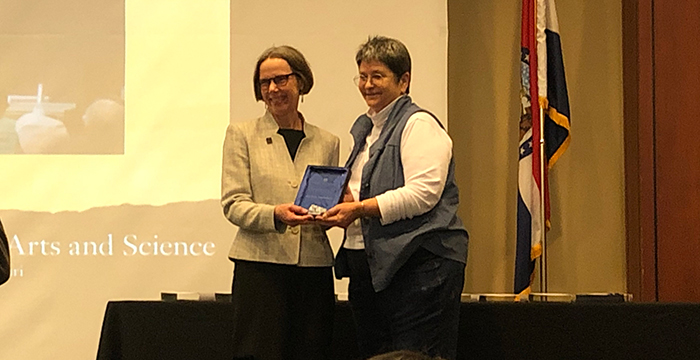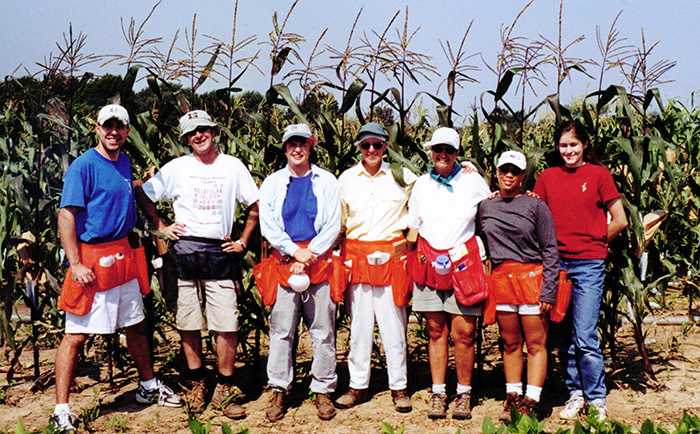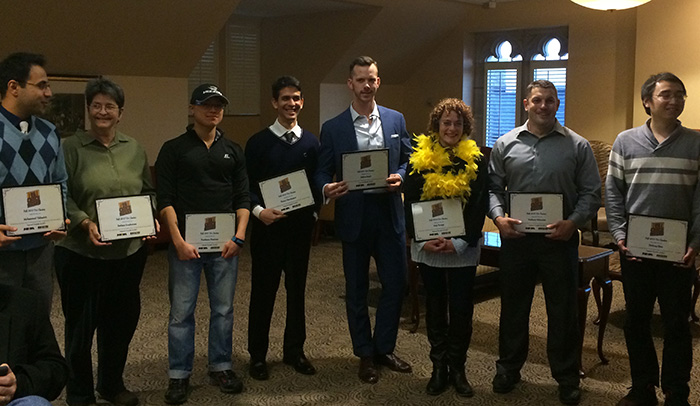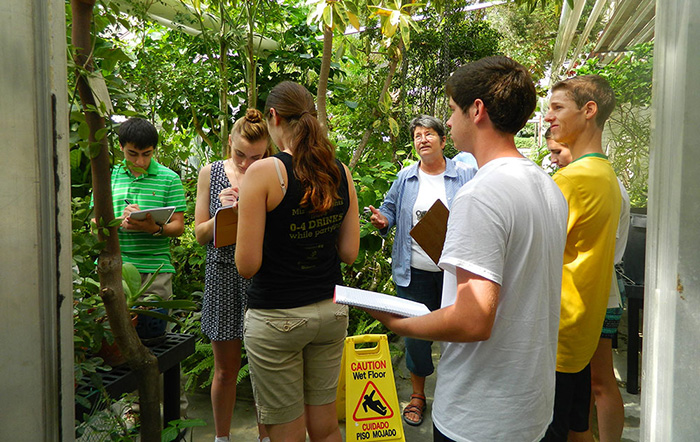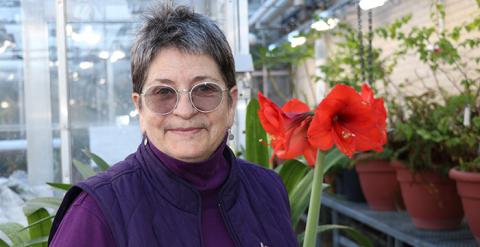Barb Sonderman Celebrated for Contributions to the College
Barb Sonderman Celebrated for Contributions to the College
Barb Sonderman has loved plants for as long as she can remember.
“My mom always had plants in our house. There were vines everywhere. My dad used to complain that he couldn’t read the paper without a vine getting in the way. In the summer, she filled the patio with plants. I thought it was beautiful,” she recalls. “I also remember following my grandpa, her dad, around his vegetable garden. He taught me how to garden.”
Looking back, she said, these early experiences instilled in her an appreciation for plants and the roles they play in our life. “I’ve just always thought it was cool to be so closely associated with plants.”
Today, Sonderman shares her own passion for plants with others as manager of the Tucker Hall Greenhouse and as a teaching assistant in two plant biology courses. For her contributions, Sonderman was recently recognized and celebrated by the College of Arts and Science with its inaugural Staff Member of the Year Award.
Professor Pat Okker, Dean of the College of Arts and Science, presented Sonderman with a plaque at a ceremony during Arts and Science Week this month. She said Sonderman is “a true asset” to Mizzou. “Her love of plants—and people—is evident in everything she does, and she has greatly enriched the learning environment for our faculty, staff, and students.”
Sonderman said she has been blessed to spend 33 years sharing her passion for plants with others–getting an honor for it is icing on the cake.
“The College of Arts and Science and the Division of Biological Sciences have been a part of my life for a long time. I received my education from the College and then it provided me a rewarding career working with beautiful plants and amazing and kind people,” she said. “Being selected for such a distinguished award is humbling, especially when I know how many talented, creative, and hardworking staff work in the College. I am sincerely honored.”
A Winding Path
Like a good garden path, Sonderman’s journey to the Division of Biological Sciences had several twists and turns with a few surprises along the way.
The St. Louis native came to Mizzou in the 1970s to study archaeology. Her choice of majors was influenced by long-standing interests in both Native American cultures, and, as she put it, “looking down and finding stuff.” After graduation, she landed a summer job as an archaeology assistant for EarthWatch in San Augustin Acasaguaslan in Guatemala. While she went in search of jade and obsidian artifacts, she uncovered something unexpected in the lush river valleys that summer.
“Being around all that tropical foliage and seeing how the indigenous peoples used plants just reawakened that interest in plants in me,” she said.
Sonderman returned to MU and took courses on ethnobotany, thinking she wanted to study how different cultures use plants. A desire to know more about plants themselves led her to take a botany course and then a plant taxonomy course. One thing led to another, and she soon found herself with a second bachelor’s degree, this time in horticulture. Her first jobs out of school were in florist shops and, for a time, she ran her own native landscaping business. When a position opened up in 1987 to take care of plants for biology researchers, Sonderman said she jumped at the chance to be back on campus.
“Something inside me said, of all these paths you’ve taken, this is the one,” she said.
Located in the southeast corner of Research Park off of Providence Road, Botany Greenhouse (or, simply, Botany) is home to several research projects. As a senior research technician, Sonderman is responsible for helping grow and care for the plants in the facility. At the time, most of the researchers working at Botany were corn geneticists. “I spent a lot of time growing thousands of pots of corn under grow lights,” she recalled.
Karen Cone was one of those geneticists. Before long, Sonderman was planning, planting, pollinating, harvesting, and cataloguing hundreds of rows of corn for Cone. While maintaining these corn nurseries was a job that ran throughout the year, Sonderman said the most exhausting part was when the corn plants were ready to be pollinated.
“Every day, we’d go to the field in the morning before the pollen started shedding. I had my apron. I had my list of plants to pollinate. I’d take pollen from certain plants and use it to pollinate another plant, which was often a whole field away. It was a day spent like that: walking a lot, standing in the sun, pollinating, eating lunch, and then going back out and doing it all again. Then doing it all the next day, even on weekends, for an entire month,” she said. “It is exhausting work.”
The job did have its upsides. Cone’s winter nursery was in Puerto Rico, which meant Sonderman would spend an entire month on the island crossing the plants. “We’d shoot bag the field for hours and then spend the rest of the day exploring Puerto Rico,” she said. “We had some great times.”
While Cone moved on to a new position several years ago, Sonderman continues to assist researchers who have projects at Botany. Over the years, those researchers have included three other corn geneticists, Kathy Newton, Don Miles, and David Braun; prairie ecologists Clair Kucera and Lauren Sullivan; plant biologists Candi Galen, Billie Cumbie, and Chris Pires; herpetologists Ray Semlitsch and Carl Gerhardt; and Rex Cocroft who studies plant-insect interactions.
“We all benefited not only from her depth of knowledge about plant biology and husbandry and her ‘feeling for the organism’ that led her to discover ways to keep a dozen species of ‘non-model’ research plants happy, but also from her warmth and enthusiasm,” shared Cocroft.
In 2004, Sonderman was singled out for her excellence with receipt of the Chancellor’s Outstanding Staff Award, the highest honor bestowed to staff by the campus.
Coming Full Circle
Sonderman’s reputation as a first-class plant expert eventually reached the desk of Associate Professor Gerry Summers. Summers coordinates the undergraduate studies program for the Division of Biological Sciences. Looking for additional teaching assistants, Summers asked Sonderman if she would be interested in helping out with two courses, plant taxonomy and botany.
“Those were, by far, my two favorite courses as an undergrad. It was almost like it was meant to be, like I had come full circle,” said Sonderman.
She soon discovered that her passion for plants was rivaled only by her passion for teaching students. “It’s the best part of my job,” she said. “The students energize me. I feel like I impact their lives in a small but positive way, and they do the same for me.”
It’s a symbiotic relationship. Students clearly get a lot from Sonderman. They praise her enthusiasm, her readiness to help them, and her welcoming attitude. In 2015, she was selected her for the TA Choice Award, an award that is student nominated. She also has twice been a finalist for MU’s Mick Deaver Memorial Award for Student Relations Excellence.
Sarah Unruh (Ph.D., ’19) is one of the students who took plant taxonomy with Sonderman. She admitted in an article in the Maneater that she enrolled in the course as a junior on a bit of a lark. “I had no idea what plant systematics was, and I had never had any courses about plants before.” While she simply hoped to learn more about plants, she walked away with a whole lot more, thanks in large part to Sonderman.
“Barb’s love of plants and enthusiasm for sharing her knowledge left a permanent impression. I came into her class unsure of what I would do with my studies and I left passionate about plant research,” Unruh said. “I gained not only knowledge, but also an appreciation for plant diversity, as her enthusiasm is that infectious.”
Unruh went on to study plant evolution as a graduate student in the Division of Biological Sciences at MU. As a graduate student, she called it a “privilege” to assist in the same plant systematics course “in which Barb helped inspire me.” Today, Unruh is inspiring even more students to study plants as an assistant professor at Illinois College.
A Botanical Legacy
Sonderman had her own inspirational teachers who shaped her love of plants.
Professor David B. Dunn joined the faculty in the Division of Biological Sciences as a plant biologist in the 1969. “Doc,” as students called him, arrived on campus as Tucker Hall was being constructed. At the time, the building was intended to house faculty from the Botany Department, and a teaching greenhouse was attached to the building. Dunn had a say in the design of the teaching greenhouse and filled it with plants he had collected on field trips with students throughout Mexico and South America. Today, the greenhouse, which includes a desert room, a cactus garden, and a tropical room with a pond, is home to between 500-800 species of plants, many from Dunn’s original collections.
Sonderman took Dunn’s plant taxonomy course as an undergrad, which involved spending a lot of time in the Tucker Greenhouse learning how to identify different plant families. She said Dunn and the time in the greenhouse reinforced her decision to focus on plants and also shaped her career trajectory.
“Doc was not your typical teacher. He was really funny, and he had all these great stories. When he would lecture about a plant family, he’d tell a story about where he had collected this or that plant. He was like Indiana Jones. I really looked forward to going to his lectures. He made studying plants fun,” she said. “At that point, I was still trying to figure out how I could turn what I was learning into a career. I saw what he did and I really wanted to imitate it at some level. I wanted to take care of plants and share my knowledge the way he shared his knowledge with me.”
She found that she particularly enjoyed being able to identify a plant’s family by looking at its leaves or flowers or other physical characteristics. She credited Dunn as well as another professor in the Department of Horticulture, Ron Taven, for teaching her this skill. “Ron’s classes were every bit as fun as Doc’s,” she recalled. “He would take students around campus and teach us the scientific names of the trees and shrubs. Those two men really showed me that taxonomy was something I enjoyed and that I would like to do.”
When she was asked in 2011 to manage the Tucker Greenhouse, Sonderman said she was beside herself with excitement. By that time, she had already started assisting with the plant taxonomy course. Teaching Dunn’s former class and taking care of “his” greenhouse seemed like a dream come true to Sonderman.
“To help teach students what my mentors taught me and to also take care of the Tucker Greenhouse felt like I hit the jackpot,” she said.
She immediately came up with a list of things she wanted to do. First on the list, she said, was opening the greenhouse up to the public. She immediately replaced the metal doors with glass doors, so anyone passing by could see the plants inside and feel welcome. She also started giving tours of the greenhouse to groups both on and off campus. She guides visitors using a page from her former mentors’ book.
“I love to tell stories about the plants when I give tours of the greenhouse. I know from my own experience with Doc and Ron that what people remember is how your storytelling about this or that plant made them feel,” she said.
She also opened up the greenhouse to other courses and faculty on campus. Today, students and teachers from English, journalism, art, entomology, natural resources, and horticulture are using the greenhouse.
“Before Barb, the Tucker Greenhouse was a treasure hidden behind metal doors,” said Teaching Professor Bethany Stone. “It had limited hours. Many students didn’t know it existed or, if they knew about it, they thought it was off limits to them. Even most staff and faculty in Tucker Hall didn’t know they could go in. She changed all that.”
Carrying on Dunn’s legacy means a lot to Sonderman. “Doc is definitely someone who influenced my passion for plants,” she said. “Often when I go out into the greenhouse and wander around looking at the plants, I think of Doc. Helping take care of his greenhouse has really been a gift to me.”
